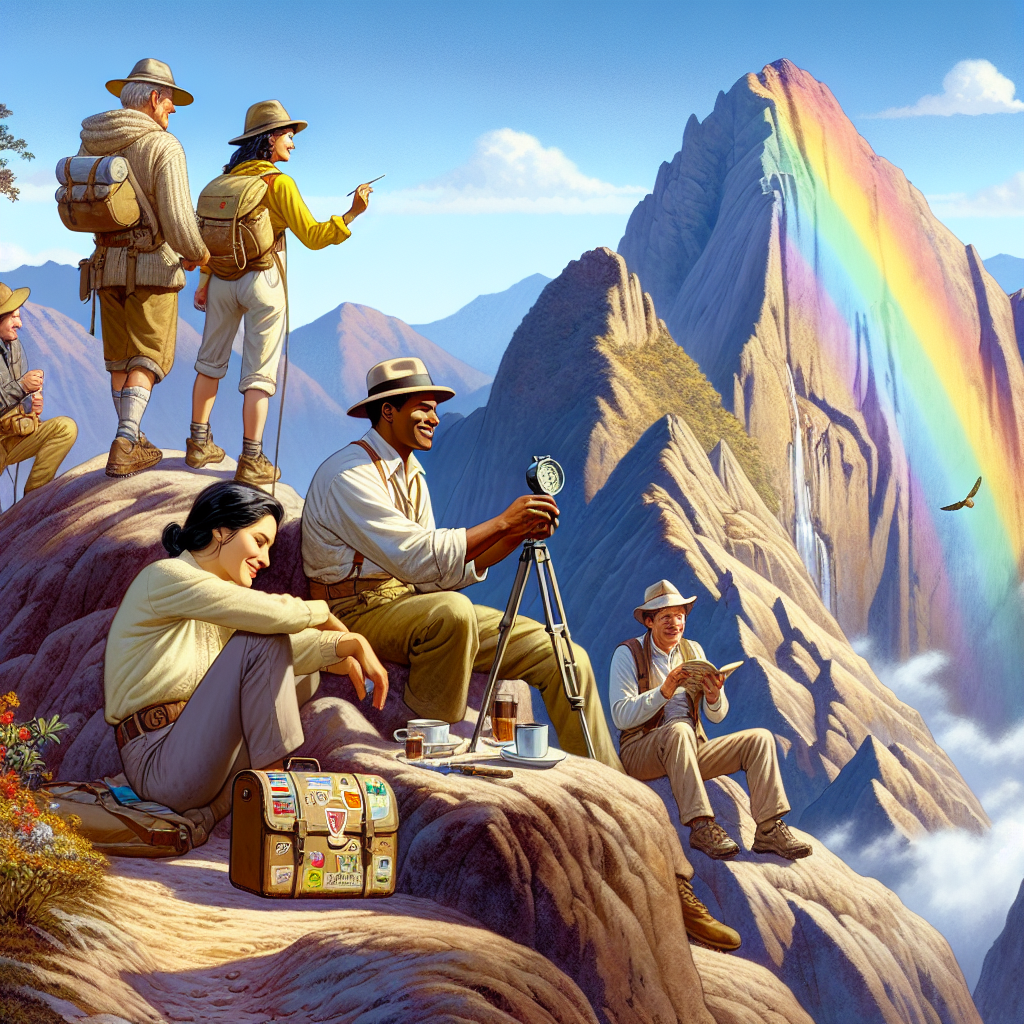
#ez-toc-container {
background: #f9f9f9;
border: 1px solid #aaa;
border-radius: 4px;
-webkit-box-shadow: 0 1px 1px rgba(0, 0, 0, .05);
box-shadow: 0 1px 1px rgba(0, 0, 0, .05);
display: table;
margin-bottom: 1em;
padding: 10px 20px 10px 10px;
position: relative;
width: auto;
}
.ez-toc-container-direction {
direction: ltr;
}
.ez-toc-list-level-1 a{
font-weight:bold;
}
Table of Contents
1. Introduction to Rainbow Mountain: A Natural Marvel
When it comes to natural wonders that capture the imagination, Rainbow Mountain in Peru stands out as an exceptional marvel. Known locally as Vinicunca or Montaña de Colores, Rainbow Mountain is a geological formation situated in the majestic Andes, offering travelers a vibrant visual spectacle that feels almost otherworldly.
Located in the Cusco region, Rainbow Mountain is part of the towering Ausangate mountain range. This part of the Andes is deeply significant, not just for its natural beauty, but also for its cultural history and the rich traditions of the indigenous Peruvian communities. For adventurers and hikers, the journey to Rainbow Mountain serves as both a physical challenge and a deeply rewarding visual feast.
- Geographical Location: Nestled at an altitude of over 5,000 meters (16,000 feet) above sea level, Rainbow Mountain is not easily accessible, requiring a hearty trek through changing landscapes that transition from lush green valleys to rugged mountain paths.
- Significance: Beyond its natural allure, this region holds spiritual value. It is considered sacred by the local Quechua people, who see Ausangate as a deity and a principal part of their Andean mythology.
One of the most striking features of Rainbow Mountain is its unique colorful appearance. The mountain’s vibrant stripes of red, turquoise, yellow, and green are not the result of any man-made intervention but are naturally occurring due to a variety of mineral deposits. Each hue tells a part of the Earth’s long geological history:
- Red and Pink Stripes: These colors are derived from red claystone (sedimentary rock) and iron-rich sediment.
- Turquoise: This comes from phyllite and other compounds containing ferrous minerals.
- Yellow and Gold: These shades can be attributed to iron sulphide, also known as fool’s gold.
- Green: The result of chlorite and other vegetation indicative of life even in low-lying regions.
Over the years, Rainbow Mountain has garnered significant attention, cementing its status as a prime destination for adventure seekers and nature enthusiasts from around the world. The allure of trekking through the stunning Andean scenery to reach this kaleidoscope of colors draws thousands of tourists annually, despite its demanding elevation and weather challenges.
- Photography Hotspot: With its awe-inspiring views, Rainbow Mountain has become a favorite among photographers aiming to capture its ethereal beauty.
- Adventure Tourism: Its growing popularity has spurred the development of trails and guided tours, making it more accessible while still preserving its raw and untouched aura.
The burgeoning interest in Rainbow Mountain as a tourist destination has not only highlighted the mountain’s intrinsic value but has also brought attention to the importance of sustainable tourism practices. Efforts are being made to ensure that this natural marvel can be enjoyed by future generations without compromising its pristine condition. Thus, Rainbow Mountain stands as a testament to the Earth’s geological artistry and a reminder of the need to protect such irreplaceable natural treasures.

2. The Hike to Rainbow Mountain: A Thrilling Adventure
Embarking on the hike to Rainbow Mountain, or Vinicunca, is nothing short of a thrilling adventure that tests both physical and emotional boundaries. Nestled in the Peruvian Andes, this kaleidoscopic mountain invites trekkers from around the globe to witness its spectacular hues of terracotta, turquoise, and gold. Climbing to its heights is challenging, but the rewarding vista from the summit makes every grueling step worthwhile.
The journey begins with a demanding trek along steep trails and high altitudes. Hikers must navigate paths that serpentine through the rugged terrain, each turn offering a glimpse of the breathtaking natural beauty that unfolds along the way. As trekkers ascend, they can feel their heart rate quickening—not just from the exertion, but from the anticipation of what lies ahead.
Physical and Emotional Aspects of the Trek
The hike to Rainbow Mountain is an endurance test that requires both mental and physical preparation. It’s not uncommon for trekkers to experience a mix of emotions—from excitement and determination to bouts of exhaustion. The physical challenge lies in the elevation, with the peak sitting over 5,000 meters (16,404 feet) above sea level. The air grows thinner, and every breath becomes more labored, demanding mental fortitude to push through.
Emotionally, the trek is a sort of pilgrimage, a journey that takes individuals to the edges of their comfort zones. Many hikers report an overwhelming sense of accomplishment upon reaching the summit, where the view of the vibrantly colored landscape stretching out beneath them feels like a reward for their perseverance. This mix of physical exertion and emotional satisfaction is what makes the trek so memorable and profound.
Tips for Preparing for the Hike
Altitude Acclimatization
Acclimatization is paramount when planning a trek to Rainbow Mountain. Altitude sickness can pose serious risks, and proper acclimatization reduces these risks significantly. It is advisable to spend at least 2-3 days in Cusco or other high-altitude areas to allow your body to adjust.
- Stay hydrated; drink plenty of water.
- Eat light, high-carbohydrate meals.
- Avoid alcohol and caffeine before the trek to prevent dehydration.
- Take it slow and allow your body time to adapt to the higher altitudes.
Fitness Requirements
Preparing physically for the hike is just as important. While you don’t need to be an ultra-marathoner, a moderate level of fitness helps manage the physical demands of the trek. Focus on exercises that enhance cardiovascular endurance, strength, and flexibility.
- Engage in regular hiking or brisk walking several weeks before your trip.
- Incorporate stair climbing or hill workouts to mimic inclines.
- Practice yoga or stretching exercises to improve flexibility and balance.
- Consider interval training to boost stamina and recovery times.
Gear Essentials
Having the right gear can make or break your hiking experience. Unpreparedness can lead to discomfort or even injury, so it’s crucial to pack wisely:
- Footwear: Invest in sturdy, waterproof hiking boots that have been broken in prior to the trek. Comfortable and supportive footwear is non-negotiable.
- Clothing: Dress in layers to accommodate changing temperatures. A moisture-wicking base layer, insulating mid-layer, and waterproof outer layer are recommended.
- Backpack: A lightweight backpack with chest and waist straps to evenly distribute weight is essential. Include snacks, water, a first aid kit, and sunscreen.
- Walking poles: These can help reduce the strain on your legs during steep ascents and descents.
Insights from Experienced Hikers and Local Guides
Seasoned hikers and local guides offer invaluable advice for those embarking on this amazing trek. Many suggest taking time to appreciate the environment around you as it transitions from lush greenery to stark, barren landscapes the closer you get to the summit.
Experienced guides recommend starting the hike early in the morning. The weather is often clearer and you can avoid the crowds, enhancing the feeling of solitude and immersion in nature.
Another tip from locals is to engage with the local culture. Along the way, you may encounter traditional Peruvian communities. Taking a moment to appreciate their way of life can add depth to your journey.
As one seasoned hiker put it, “The trek to Rainbow Mountain is a heart-pounding dance with nature. Every step is a promise to yourself that you can conquer discomforts and witness the extraordinary that the world has to offer.”
The hike to Rainbow Mountain offers more than just a colorful vista; it is a transformative challenge that invigorates the spirit and strengthens resolve—a truly unforgettable adventure that’s worth every ounce of effort.

3. Experiencing the Beauty and Culture of the Andes
Embarking on a journey through the Andes is an adventure of a lifetime, where travelers can immerse themselves in the unparalleled beauty and rich cultural heritage of this majestic mountain range. This journey offers not just breathtaking views and engaging ecosystems but also an inviting encounter with the traditions and communities that call these highlands home.
Stunning Landscapes and Diverse Ecosystems
The Andes stretch over 7,000 kilometers along South America’s western coast, presenting an array of awe-inspiring landscapes that transition dramatically from north to south. As trekkers venture through the Andes, they are greeted with imposing glaciers, lush cloud forests, arid deserts, and verdant valleys. These regions host a stunning diversity of ecosystems that notably influence the biodiversity and climatic conditions experienced along this vast mountain range.
- The Atacama Desert: Known as the driest desert in the world, the Atacama Desert offers unique geological features such as the Valley of the Moon and salt flats, where flamingos can often be seen. This region is perfect for stargazing due to its clear night skies.
- Altiplano: This high plateau is rich in wildlife and offers views of shimmering lakes and a backdrop of snow-capped peaks. The region is also home to rich mineral deposits and ancient Incan trails.
- Cloud forests: Found in the more tropical regions of the Andes, cloud forests are teeming with life, showcasing a complex ecosystem of orchids, bromeliads, and a variety of bird species.
- Glaciers and Peaks: The towering peaks of the Andes are covered with vast icefields and glaciers, such as those in Patagonia, offering breathtaking vistas and the chance for ice trekking adventures.
Rich Cultural Heritage and Indigenous Communities
The Andes are not just a natural wonder but also a magnificent cultural tapestry woven from centuries of history. Indigenous communities have called this region home for thousands of years, enriching it with a legacy of traditions, folklore, and practices that continue to thrive today.
- Quechua and Aymara Cultures: Predominantly found in countries like Peru and Bolivia, these communities preserve their heritage through language, art, and music. Travellers have the opportunity to participate in festivals and rituals that have been passed down through generations.
- The Inti Raymi Festival: Hosted each June, this celebration of the sun brings together locals and tourists alike in a resplendent display of traditional Incan music and dance.
- Traditional Weaving and Crafts: Visitors can explore local markets where beautifully handwoven textiles are sold, each piece telling a story through its patterns and colors, reflective of the surrounding landscapes.
- Culinary Delights: Andean cuisine is a delicious journey on its own, featuring traditional dishes like ‘pachamanca,’ a meal cooked underground, and ‘cuy,’ a regional delicacy.
Additional Attractions and Activities
For those looking to extend their adventure beyond the traditional trek, the Andean region offers a myriad of attractions and activities that promise to enchant and exhilarate.
- Machu Picchu: No trip to the Andes would be complete without visiting the mystical ruins of Machu Picchu. This UNESCO World Heritage site is a testament to the architectural prowess of the Inca civilization.
- Lake Titicaca: Straddling the border of Peru and Bolivia, Lake Titicaca is the world’s highest navigable lake. Visitors can take boat tours to explore the floating Uros Islands, crafted entirely from reeds.
- Adventure Sports: The diverse terrain of the Andes is ideal for a range of adventure sports including white-water rafting, paragliding, and mountain climbing, catering to thrill-seekers of all skill levels.
- Colca Canyon: Twice as deep as the Grand Canyon, Colca Canyon in Peru offers stunning views and is home to the Andean condor. Hiking this canyon provides a unique opportunity to witness these majestic birds in flight.
In summation, the Andes is more than an exotic destination; it is an invitation to discover a world where nature’s grandeur and cultural richness come together. Whether through awe-inspiring landscapes, encounters with indigenous cultures, or the exhilarating activities on offer, the Andes promise an escapade that captivates the soul and inspires the spirit.
4. Sustainability and Responsible Tourism
“`html
Sustainability and Responsible Tourism in Rainbow Mountain
Rainbow Mountain, known locally as Vinicunca, is one of Peru’s most breathtaking and increasingly popular tourist attractions. However, this natural wonder is facing significant environmental threats due to the rapid increase in tourism over recent years. Addressing the environmental impact of tourism on Rainbow Mountain and promoting responsible travel practices are crucial steps towards preserving its natural beauty and cultural integrity.
Environmental Impact of Tourism on Rainbow Mountain
With its unique mineral layers creating vibrant colors across its landscape, Rainbow Mountain has captivated the global imagination. Unfortunately, the influx of tourists is taking a toll on the environment. The most pressing ecological concerns include:
- Soil Erosion: The constant foot traffic from thousands of tourists each year accelerates soil erosion, particularly in areas with fragile and thin topsoil. This erosion can alter the landscape and lead to loss of vegetation.
- Waste Management Issues: The remote location of Rainbow Mountain makes waste management challenging. Often, waste is either left behind or improperly disposed of, leading to pollution of the pristine environment.
- Disturbance to Wildlife: The presence of large numbers of visitors can disrupt local wildlife. Animals become stressed or displaced, which can have a cascading effect on the local ecosystem.
Advocating for Responsible Travel Practices
To combat these impacts, it is vital to advocate for responsible travel practices. Travelers can play a crucial role by:
- Following Established Trails: Encouraging tourists to stay on designated paths minimizes damage to untrodden vegetation and reduces the risk of erosion.
- Carrying Out All Waste: Promoting the principle of ‘Leave No Trace’ ensures that litter and personal waste are not left on the mountain.
- Respecting Local Culture: Understanding and honoring the traditions and customs of the local communities fosters cultural preservation and mutual respect.
- Choosing Responsible Tour Operators: Opt for operators who prioritize sustainability and community engagement, thereby supporting enterprises that uphold environmental and social standards.
Importance of Preserving Natural Beauty and Cultural Integrity
The allure of Rainbow Mountain goes beyond its striking visuals; it is also a sacred site with profound spiritual importance to local communities. Preserving its natural and cultural heritage ensures that future generations can enjoy and be inspired by its majesty. Here are reasons why preservation is essential:
- Ecological Balance: Maintaining the ecosystem ensures that native plant and animal species continue to thrive.
- Cultural Preservation: Protecting sacred sites and respecting Indigenous knowledge helps safeguard traditional practices and beliefs.
- Economic Benefits: Sustainable tourism provides economic opportunities for local communities without compromising future resource needs.
Initiatives and Organizations Working Towards Sustainable Tourism in Peru
Several organizations are actively working to foster sustainable tourism practices in Rainbow Mountain and across Peru:
- CANATURA (The National Chamber of Tourism): Aims to integrate sustainability principles within the tourism industry by promoting eco-friendly practices among its members.
- The Mountain Institute: Has been involved in conservation projects in the Andes, promoting sustainable land use and education programs that empower local communities.
- Peruvian Ministry of Environment: This government body has instituted regulations to manage tourist flows and minimize environmental impacts on natural sites like Rainbow Mountain. Their strategies include promoting ecotourism and enforcing strict waste management policies.
- AWAMAKI: A non-profit organization that collaborates with rural Andean communities to create economic opportunities through tourism while respecting and preserving existing cultural traditions.
By supporting and advocating for these initiatives, tourists can contribute to the protection and sustainable enjoyment of Rainbow Mountain. As stewards of the earth, embracing responsible tourism is our collective responsibility to preserve such natural wonders for future generations.
“`


